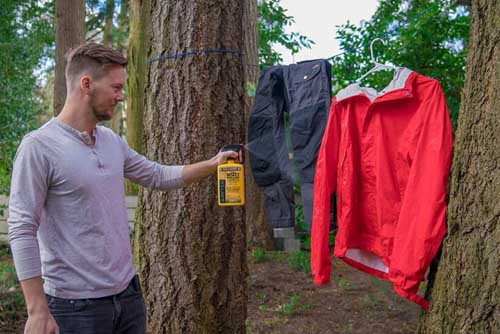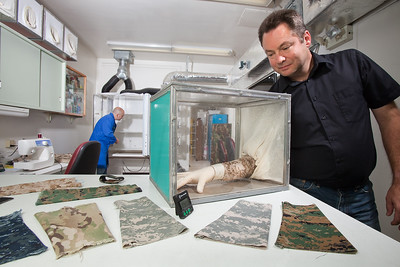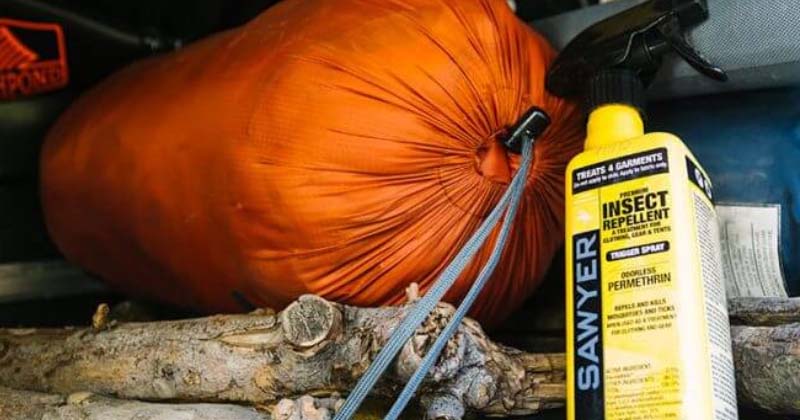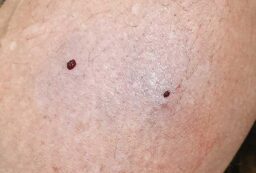While there are some natural ways to keep ticks off of you, permethrin is the only reliable and effective way to prevent tick bites. Considering that ticks can transmit over a dozen diseases in addition to Lyme, it’s well worth using to keep yourself safe from ticks.
Even though permethrin has been commercially available since 2003, it’s only recently started to get popular with hikers, backpackers, and outdoor enthusiasts. A lot of the reason for this is because people simply didn’t know how to use permethrin and weren’t sure about safety. Here, I’ll go over everything you need to know to use permethrin against ticks, including how to apply permethrin and get the most out of treatments.
*Even if you do wear permethrin-treated clothing, make sure you still bring tweezers or another tick removal tool with you! The faster you get a tick off, the less likely you are to get an infection. Read more about tick tools for humans here.
Jump to:
How to Apply Permethrin
There are two ways you can apply permethrin to clothing: spraying it onto your clothes or soaking your clothes in a solution of permethrin. The spray method is easiest, especially if you only have a few items to treat. The soak method is better if you have lots of items to treat. Soaking also does a better job of coating the fabric and the treatment will last longer. Below are step-by-step instructions for each method.
Permethrin Spray Instructions

1. Use only permethrin designed for clothing.
Don’t use permethrin pesticides meant for plants. These won’t stick well to clothing and will wear off too quickly. Sawyer Permethrin spray is the most popular. Get it here at Amazon or here at REI.
2. Hang your clothing in a well-ventilated area.
Ideally apply the permethrin spray outdoors. You can also apply it in your garage or any other area with good ventilation.
- Never apply permethrin while wearing the clothes!
- Stand up-wind while applying the permethrin spray.
- If you have one, wear a face mask rated for aerosols.
- If you have a cat, make sure the clothing is out of reach of your cat.
3. Spray the Permethrin
- Hold the bottle 6-8 inches away from the clothes while spraying
- Spray from the top of clothes to bottom
- Make sure you get the cuffs of your sleeves and pants well. This is where ticks frequently climb onto your skin.
4. Apply an even coating.
You want the clothing to be completely damp with permethrin but not so wet that it is dripping. Don’t be stingy when applying it! If the clothing doesn’t get completely covered with permethrin, it won’t be as effective at repelling ticks.
Tip: Check the product to see how much one bottle should treat. This will let you know whether you are applying enough of the spray. For example, 4.5oz of Sawyer Permethrin spray will treat a complete outfit consisting of a shirt, pants, and socks.
5. Flip clothes and treat the other side.
Again, move from top to bottom and make sure you get the clothing wet.
6. Let clothing completely dry.
It’s important that you let the clothing dry while hanging. Once dry, the clothing is safer to handle. It can take a few hours for the clothing to dry, especially if it is humid out. So make sure you apply the permethrin treatment at least a full day before you plan to wear them.
There’s debate about whether you can dry permethrin-treated clothing in the drier to speed up the process. In general, the answer is no because it could break down the treatment and make it less effective. Just be patient.
Permethrin Soak Instructions
1. Get Permethrin Made for Clothing
You can find concentrated permethrin for sale at places like Amazon. However, most of these are actually meant for plants/agriculture and should NOT be used on clothing. It won’t stick well and will wash off quickly.
The brand Duration used to make a 10% solution of permethrin that could be used on clothing, but it hasn’t been available for a while (check here![]() ). They do still sell a pre-mixed bulk jug of 0.5% permethrin. You can also use any permethrin clothing spray; you just might need a few bottles of it.
). They do still sell a pre-mixed bulk jug of 0.5% permethrin. You can also use any permethrin clothing spray; you just might need a few bottles of it.
2. Calculate How Much Permethrin You Need
How much permethrin do you need for soaking? The military uses 4.5oz of permethrin per uniform. Sawyer used to recommend about 3oz of diluted permethrin per garment (they now only give amounts for spraying, not soaking). See the FAQs for a more detailed way of calculating permethrin amounts.
3. Dilute Permethrin to 0.5%
Permethrin for clothing should be diluted to 0.5% concentration. This means the solution will contain 0.5 grams of permethrin per each 100 mL of solution.
To dilute permethrin concentrate, first see what percentage the product is. Sawyer Permethrin spray is already diluted to 0.5% so does not need to be diluted. Duration Permethrin, however, is 10% permethrin. You’d need to dilute it to 1 part permethrin and 19 parts water. Here’s a good dilution calculator.
*Wear gloves while mixing permethrin!
4. Put Clothing and Permethrin Solution in Plastic Zip Bags
Some people soak their clothes in permethrin in buckets. It works, but you end up with a lot of waste. Instead, it’s better to use a plastic bags.
- First put your clothing item/s into the bag. Make sure it fits and there is adequate space left over.
- Pour the pre-mixed permethrin solution into the bag. You’ll need about 3oz per garment, or you can do the math to find a more exact amount.
- Gently squeeze the bag. You want to get the permethrin into the clothing fibers. The item should be damp all over.
- Add more permethrin if necessary. If the clothing item still has dry spots and there isn’t any liquid left in the bag, add some more 0.5% permethrin solution to the bag.
5. Let Clothing Sit in Solution
Leave the clothing to sit in the permethrin solution for about an hour. You can roll down the tops of the bags and put rubber bands around them so they are less likely to leak.
6. Remove Clothes and Hang to Dry
While wearing gloves, take the clothes out and put them on hangers to dry. Ideally you should do this in a place which has ventilation but is not in direct sunlight. The UV rays in sunlight will break down the permethrin. Your garage or yard in the evening are good places.
Once dry, you can wear the treated clothing immediately. There’s no need to wash them before wearing; that will actually just start breaking down the permethrin treatment.
7. Disposing of Unused Permethrin
Do not pour permethrin down the drain. It is very harmful to aquatic life. You also don’t want to dump it onto the ground where it could get into the ground water.
The good news is that permethrin is inactivated by UV light. So, the best way to dispose of unused permethrin is to leave it outside in a bucket exposed to sunlight. Ideally, wait until the permethrin has completely evaporated from the bucket.
Permethrin FAQs
What Clothing Should You Treat with Permethrin?
Studies show that, during spring and summer, ticks are most likely to get onto your body by crawling up your feet and ankles. Thus, it is really important you treat your shoes and socks with permethrin. This alone has been shown to reduce your likelihood of getting bit by ticks by nearly 74x. By contrast, treating just your shirt and shorts only reduce your likelihood of getting bit by 2x. (Source)
However, it doesn’t make much sense to treat just your socks and shoes. Do you ever sit down while hiking? Dig a cathole to go to the bathroom? Stop to forage some wild berries? These are just some of the situations where nymph ticks from the ground can get to your upper body.
For best results, treat these items with permethrin:
- Shoes and socks
- Pants (preferably wear long pants not shorts)
- Shirt (preferably long sleeves)
- Jacket
- Hat (this is especially important for keeping ticks out of your hair)
- Backpack, tent, and other gear made from fabric
Note the EPA says that you should NOT treat your underwear with permethrin. Likewise, don’t treat the INSIDE of tents or sleeping bags.
Can You Use Permethrin Water-Resistant and DWR-Treated Clothing?
Yes, permethrin can be used on water-resistant clothing. It won’t damage the waterproofing. The only downside is that the permethrin will wear off faster than if you’d applied it to a more absorbent material like cotton.
If you apply your own water-resistant coating to clothes (such as a DWR spray), it is important that you apply the DWR treatment before the permethrin treatment. Otherwise the permethrin will get trapped below the DWR and won’t be effective.
What about Using Permethrin on Waterproof Clothing?
You could apply permethrin to waterproof clothing such as rain jackets. Some of the permethrin would stick and help with preventing ticks. However, the coating will wear off very quickly. It’s probably not necessary anyway because insects can’t get through true waterproof gear like they can through water-resistant gear.
How Much Permethrin Should You Use on Clothing?
Sawyer recommends using 3oz of permethrin per garment or 4.5oz of permethrin for a complete outfit (shirt, pants and socks). The US Military uses 4.5oz for a uniform. Considering that clothing varies drastically in size and thickness, these are obviously just rough estimates.
If you want to be very exact (and don’t mind doing some math), here is a more exact method of calculating how much permethrin to use on clothing:
- Mesh: 0.10 to 0.50 grams of active permethrin per square meter of fabric
- Cotton and thin fabrics: 0.70-1.20 grams of active permethrin per square meter of fabric
- Thicker fabrics: 0.65 to 1.25 grams of active permethrin per square meter of fabric.
How much fabric is in a garment? I did an internet search and here’s what I found (amounts given for medium size)
- T-shirts: 1.7 to 2.1 square meters of fabric
- Pants: 1.7 to 2.5 square meters
Remember not to be stingy when applying permethrin. The Army found that increasing the amount of permethrin applied to uniforms from 3oz to 4.5oz increased the protection time from 2-3 weeks to 6 weeks. By applying enough permethrin to truly saturate the fabric fibers, you save money in the long run.
Washing and Caring for Permethrin-Treated Clothing
Home-applied permethrin treatments will generally last through four to six washings or 6 weeks. It’s best to hand wash or wash on the gentle cycle.
Because oxygen and UV light break down permethrin, store treated clothing in a sealed plastic bag away from sunlight. The treatment will last much longer this way. Just make sure your hiking clothes are completely dry before you put them in the plastic bag or they will get stinky and moldy!
Random Tip: I’ve recently invested in good Merino wool hiking shirts. They don’t get stinky like synthetic shits do, so I can go a lot longer without washing them. Also read: Is Merino Wool Worth It?
How Often Should I Apply Permethrin?
DIY permethrin treatments need to be redone after 4-6 washings. Shoes should be treated again after about 4-6 weeks.
It’s best to do permethrin treatment at the start of the tick season in spring. Because ticks are still in their nymph stage and thus closer to the ground, it’s particularly important that you treat your shoes and shocks. Later in the season, it becomes more important to treat your shirt and hat.
Permethrin Clothing vs. DIY Treatment?
There are plenty of brands which now sell permethrin clothing. The commercial treatment on these clothes will last a lot longer than DIY permethrin treatments: up to 70 washings compared to just 4-6 washings with the DIY sprays. Because of this, it is usually cheaper to buy pre-treated permethrin clothing than do it yourself.
Cost Comparison
A 24oz bottle of Sawyer Permethrin Spray costs approximately $17-$18 at REI (check price at Amazon). It will treat 5 outfits (1 pants, 1 shirt, and a pair of socks).
About half of the solution goes to the pants and the other half to the shirt and socks. That means it will cost you $9 to treat 5 pants, or $1.8 per pants.
The treatment will last up to 6 washes. Assuming you wash your pants after each wear, that means DIY treatment costs you $0.30 per wear.
Permethrin pants cost around $80 at REI but you can get 70 washes before the permethrin treatment wears off. If you wash the pants after each wear, it comes out to $1.14 per wear – plus you get the actual pants too.
REI also often has good deals on permethrin clothing (at time of writing, a lot of their permethrin clothing are 50% off and cost under $40). This makes commercial permethrin clothing much cheaper than DIY treatments.
Even if you buy pre-treated permethrin clothing, you’ll still need to get some spray for your shoes. Since shoes are where nymph ticks often get onto our bodies, you really don’t want to skimp on treating your shoes!
Reputable brands of permethrin clothing:
- Insect Shield
 : Also has clothing for kids and items like socks
: Also has clothing for kids and items like socks - REI permethrin clothing
Is Permethrin Actually Effective Against Ticks?

USDA chemist testing permethrin-treated clothing
Permethrin-treated clothing is very effective at repelling and killing ticks. It’s used by the US Military and has been tested numerous times.
One study used real human subjects and had them wear socks, shoes, shorts, and t-shirts treated in permethrin. Then the researchers put ticks on the subjects’ legs, shoe, or arm and waited two hours. The subjects wearing permethrin clothing had 3.36 times fewer bites. Most notably was that the subjects with permethrin-treated shoes were 73.6 times less likely to have been bitten. Of the ticks which did bite, only 22.6% of them remained alive vs. 97.6% of attached ticks in the control group.
Another study tracked tick bites on wildlife workers at North Carolina forest. The study found that workers wearing permethrin clothing had much fewer bites: 0.24 bites for every 100 hours spent working vs. 1.37 bites on those who didn’t wear permethrin clothing. That’s a huge difference.
Permethrin Against Mosquitoes
Permethrin can also kill mosquitoes. It has a “knock down” effect, meaning that mosquitoes which come in contact with permethrin clothing will be killed or incapacitated.
However, this only occurs if the mosquitoes land on your clothing. The permethrin doesn’t repel mosquitoes like DEET does, so the mosquitoes could just land on your face, hands, or any other exposed skin. To be effective against mosquitoes, you’d have to be wearing pants and a long-sleeve shirt treated in permethrin and have a mosquito hat on over your face.
Vs. DEET
When it comes to repelling and killing ticks, permethrin is much better than DEET. Because it isn’t applied to the skin, permethrin is also much safer than DEET. Another benefit of permethrin is that it doesn’t wear off quickly; DEET needs to be reapplied often, especially if you are sweating. Permethrin can survive several washings.
However, DEET wins hands-down when it comes to mosquitoes. It will actually repel mosquitoes and prevent them from landing on you whereas permethrin only works if the mosquitoes land on your treated clothing.
The bottom line? If you want to stop ticks, just permethrin clothing is fine. If you want to prevent tick and mosquito bites, then you’ll need to use both permethrin and DEET.
Permethrin Safety
The main reason that permethrin hasn’t gained popularity is because people are worried about spraying an insecticide on their clothing. Various government agencies have said it is safe, but a lot of people simply don’t trust what the government says. If you are one of these people, you’ll have to balance your uneasiness about using a pesticide on your clothes with the risk of tick diseases.
Permethrin works against insects and ticks by interfering with their nervous system, causing them to have brain spasms and die. Yes, this sounds scary for humans. But humans have different nervous systems, so the chemical acts differently on us.
Further, our bodies can actually handle a fairly large amount of permethrin. According to Tick Encounter Resource Center, a 140lb human can be exposed to 32 grams of permethrin per day and not have any adverse health effects. To put this in perspective, a 24oz bottle of Sawyer Permethrin spray contains 3.5 grams of active permethrin.
Permethrin is the active ingredient in lice and scabies treatments which have been used for a long time. Studies have even found that permethrin is safe for pregnant women and children. The National Pesticide Information Center says that you might feel some tingling or redness if you get permethrin on your skin, but it won’t cause serious symptoms.
This doesn’t mean you shouldn’t be careful.
- Follow the manufacturer’s instructions exactly when applying permethrin.
- Always wear gloves when applying.
- Don’t touch clothing while it is still wet.
- Wear a face mask when spraying permethrin.
- Apply spray permethrin in a well-ventilated area, ideally outdoors.
- Don’t use agricultural permethrin on your clothes.
Permethrin and the Environment
While permethrin might not be harmful to humans, it can be harmful to animals including aquatic life, bees and cats. However, it’s only dangerous while it is still wet.
That’s why it is so important you never dump unused permethrin down the drain on onto the ground. You need to leave the permethrin exposed to air and sunlight so it can deactivate and evaporate.
But what if you were to ford a stream with permethrin-treated shoes? Or it starts raining while you are hiking in permethrin-treated clothing?
According to Thomas Mather of the University of Rhode Island’s Center for Vector-Borne Disease and TickEncounter, permethrin doesn’t come off fibers once it has dried. That’s why it can go through the wash so many times and still be effective.
So, getting your permethrin-treated clothing wet won’t harm you or wildlife around you.
However, it is possible for permethrin residue to get into water treatment systems from our washing machines; we just don’t know how dangerous this is. Studies like this one have already found that streams outside of municipal areas contain levels of permethrin toxic to aquatic life. This pollution is likely from agricultural pesticides and not from treating your clothes with permethrin. I’m not trying to say that pollution from clothing treatments is okay, but realistically the bigger issue which needs to be addressed is pesticide use in farming.
Also see:
Resources:
https://tickencounter.org
https://www.consumerreports.org/insect-repellent/how-to-use-permethrin-on-clothing-safely/
https://tickinfo.com/permethrin
https://backpackinglight.com/forums/topic/permethrin-on-water-resistant-pants/
http://pmep.cce.cornell.edu/profiles/extoxnet/metiram-propoxur/permethrin-ext.html
https://www.npr.org/sections/health-shots/2018/07/09/625459326/to-repel-ticks-try-spraying-your-clothes-with-a-pesticide-derived-from-mums
https://backpackinglight.com/forums/topic/permethrin-on-water-resistant-pants/
https://thewirecutter.com/blog/permethrin-protect-from-ticks/
Book: Vector Control: Methods for Use by Individuals and Communities
https://reverseresources.net/news/how-much-does-garment-industry-actually-waste
https://www.dummies.com/crafts/sewing/estimating-fabric-yardage-needs-for-common-misses-garments/,
https://www.nzdl.org/cgi-bin/library?e=d-00000-00—off-0cdl–00-0—-0-10-0—0—0direct-10—4——-0-0l–11-en-50—20-about—00-0-1-00-0–4—-0-0-11-10-0utfZz-8-10&cl=CL2.22&d=HASH01f16a8f5683d1b9215656d3.6.4.3>=1













4 Comments
Dave Adams
July 17, 2020 at 8:18 pmGreat article, and more useful numbers than I’ve found in any other single source. But I do have a question.
Can you please explain your cost example for the Sawyer’s spray? My bottle says it will do “5 complete outfits.” That comes out to about 4.8 oz per outfit, verus the military 4.5 oz per “uniform.”
At the 3 oz. per outfit you cite as Sawyer’s recommendation, 24 oz would do 8 outfits with one bottle. At the 4.8 oz per outfit level, they do 5 outfits. One outfit with one bottle would end up with 24 oz per outfit. Wouldn’t that be in the range of 8 grams per sq. meter of material?
Also, the (current, at least) label says to re-apply after 42 days (and NOT before 42 days) or 6 washings. I wonder if that 42 day thing is a problem for long distance hikers?
Thanks for the excellent article!
Diane
July 20, 2020 at 9:56 am-Cost per outfit: That was my mistake – was using the 6oz not 24oz bottle for my calculations. I’ve fixed it. Thanks 🙂 Btw, are you sure your bottle says 5 outfits? It should be 4.
-3oz recommendation: This comes from Sawyer and is for GARMENT, not outfit. They say their 24oz treats 4 complete outfits, so 6oz per outfit. Half of that is for pants (3oz) and the other 3oz is for the shirt and socks. I have no idea how much of that 3oz is going to the shirt vs. pants.
*Remember that these are just generic guidelines. I’m a tiny woman and a 24oz bottle will do more than 4 outfits for me. A fleece will use up tons of permethrin spray or soak. Summer-type hiking pants are thin and don’t need that much.
-Long distance hikers: The recommendation is definitely something for thru hikers to think about. They probably aren’t washing their clothes that often, so the pants might be fine for over 42 days. Or maybe mail a bottle of permethrin to yourself at one stop and treat shoes and all socks during this time? For a thru-hike, it might be worth buying professional permethrin clothing (pants and shirt at least) and treating shoes before leaving on the trip. In any case, you’ve still got to check yourself for those nasty buggers every day and have a good pair of pointy tweezers in your first aid kit. 🙂
Lisa
July 18, 2023 at 3:57 pmThis is a really good & comprehensive article about permethrin. I’ve been using it for years when hiking in Missouri woods (after endless hours of research before trying it) and I have tremendous confidence in its effectiveness, because it really works. DEET never seemed to work, no matter how heavily I applied it!
Anyway, are these numbers correct?
“Cotton and thin fabrics: 10 to 0.25 grams of active permethrin per square meter of fabric
Thicker fabrics: 65 to 1.25 grams of active permethrin per square meter of fabric.” Should it be “.10 to .25” and “.65 to 1.25”?
Diane
July 19, 2023 at 4:00 pmThanks for catching that. This platform screws up decimals sometimes!